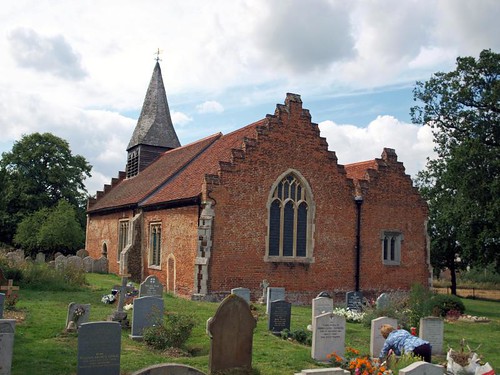ST MICHAEL. A red brick church entirely, small, but historically interesting, in that it was built in 1563-4, and yet is essentially still Gothic.* It has, it is true, stepped gables at the W and the E end, where that of the N Vestry together with that of the nave form a pretty E view, but otherwise the windows are Perp, straightheaded with each light arched and cusped, the walls have buttresses, the arcade to the N aisle has piers superficially similar to the familiar four-shaft-four-hollow type (but the hollows are straightened out) and double-hollow-chamfered arches. The roofs also are of usual Perp types. - FONT. Large, octagonal, Perp, the stem decorated with tracery, the bowl with quatrefoils. - STAINED GLASS. In a S aisle window two heads and some scenes; C15. - PLATE. Cup of 1646; Paten on foot of 1706.
* The bell-turret and the E window are of the C19.
WOODHAM WALTER. It has an Elizabethan inn among the cottages in the hollow, and a complete Elizabethan church on the side of the hill; and the wild common on the high ground inland has a romantic beauty.
The inn has carving of oak leaves and acorns and the tendrils of the vine on the woodwork of the overhanging storey, and the bargeboards on the gable add to its old-world charm.
The 16th century church is aglow with red bricks and has a red tiled roof and crow stepped gables; and it has some treasures saved from its predecessor. The most valuable of these is the font, tall and light with traceried panelling of the 15th century. There is medieval glass in the windows, seven roundels with glowing suns and the figure of a reaper in a green cap bending at his task. The reaper is the symbol of man’s labour five centuries ago; against the wall is a bronze symbolical of the work of our own century. It shows a doctor looking through a microscope, and is in memory of Henry Ayrton Chaplin, of the West African Medical Staff, who died in 1905 at Salaga while engaged in research. Over the design are these lines of Kipling:
One day this century the villagers had a great surprise. They received news that Henry Thompson, who had been their fairy godfather ever since he had come from Aberdeen to live among them at Warren Farm, had left £50,000 for the playing fields which he had established on his farm. He was one of the men who have made it impossible for honest folk ever to repeat the silly jokes about Aberdeen; he had lived here 30 years and laid out cricket pitches and football grounds on his own estate, and by his will he desired to carry on his benefactions for all time.
Simon K -
It was all slightly down hill and I soon came to Woodham Walter.
The inn has carving of oak leaves and acorns and the tendrils of the vine on the woodwork of the overhanging storey, and the bargeboards on the gable add to its old-world charm.
The 16th century church is aglow with red bricks and has a red tiled roof and crow stepped gables; and it has some treasures saved from its predecessor. The most valuable of these is the font, tall and light with traceried panelling of the 15th century. There is medieval glass in the windows, seven roundels with glowing suns and the figure of a reaper in a green cap bending at his task. The reaper is the symbol of man’s labour five centuries ago; against the wall is a bronze symbolical of the work of our own century. It shows a doctor looking through a microscope, and is in memory of Henry Ayrton Chaplin, of the West African Medical Staff, who died in 1905 at Salaga while engaged in research. Over the design are these lines of Kipling:
Take up the white man’s burden,
The savage wars of peace:
Fill full the mouth of Famine
And bid the sickness cease.
One day this century the villagers had a great surprise. They received news that Henry Thompson, who had been their fairy godfather ever since he had come from Aberdeen to live among them at Warren Farm, had left £50,000 for the playing fields which he had established on his farm. He was one of the men who have made it impossible for honest folk ever to repeat the silly jokes about Aberdeen; he had lived here 30 years and laid out cricket pitches and football grounds on his own estate, and by his will he desired to carry on his benefactions for all time.
Simon K -
A couple of miles from Purleigh brought me to the Chelmsford to Maldon
road, and as I crossed it the landscape changed completely - now it
was the Essex I remembered from bike rides last year, rich and green,
hedgerows, pretty villages and the like.
Locked, no keyholder. This was my one disappointment of the day. It
is supposed to be kept open, so I could only put the lack of a
keyholder down to someone forgetting to open it today. It is the only
church in Essex built between the Reformation and the Commonwealth,
and looks entirely Tudor late gothic, as if it was a bit fallen off a
Cambridge college. Entirely red-brick, both ends have crow-stepped
gables, although unfortunately a stupid north aisle was added by that
local vandal Chancellor in the 1860s.
Finding it locked was annoying as I shall have to go back.

No comments:
Post a Comment